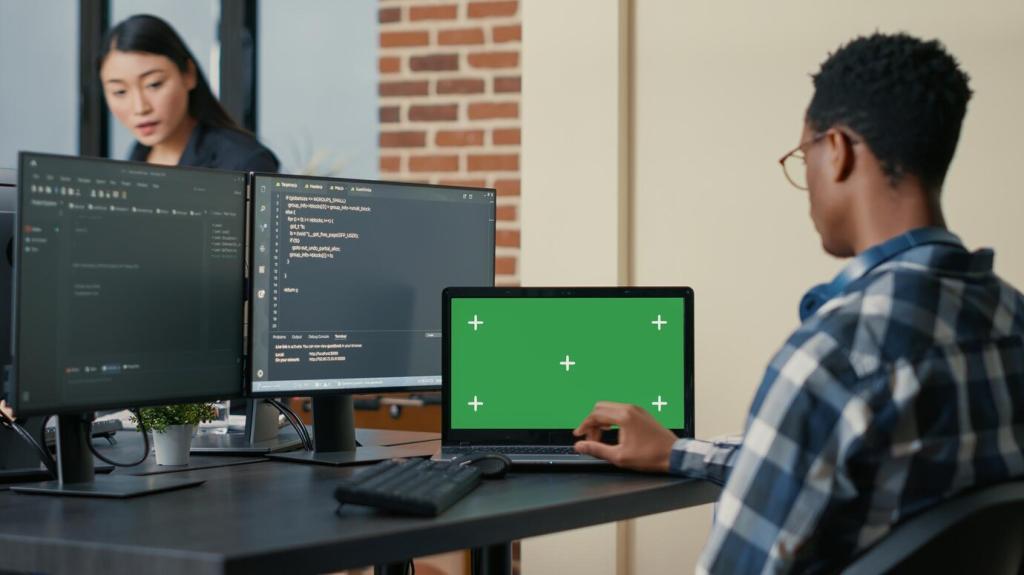
Mastering the Craft: Essential Elements of Effective Programming Language Tutorials
Chosen theme: Essential Elements of Effective Programming Language Tutorials. Welcome to a home for clear thinking and joyful learning, where we turn confusing syntax and scattered docs into guided journeys with purpose. Stay with us, share your toughest learning roadblocks, and subscribe for weekly, practical improvements you can apply to any tutorial you create or follow.
Learning Outcomes That Lead the Way
State outcomes as observable skills, like “Implement a stack using arrays” or “Debug asynchronous JavaScript with breakpoints.” When learners can verify success themselves, they feel ownership and momentum. Invite readers to post a personal outcome below and we will help refine it.
Learning Outcomes That Lead the Way
Organize topics from conceptual to concrete: model a problem, show a minimal working pattern, then add constraints and edge cases. Scaffolding prevents cognitive overload and builds confidence. Tell us how you currently sequence lessons, and we will suggest a cleaner arc.

Mental Models Before Mechanics
Explain variables as labeled boxes in memory, or promises as IOU notes that resolve later. These images make cross-language learning smoother. Share your favorite metaphor in the comments to help others remember tricky ideas longer.
Examples That Run, Scale, and Teach
Provide a One-Command Start
Offer a copy-paste snippet or a sandbox link that runs instantly. Fast feedback fuels exploration. If your example needs setup, include a starter script and preloaded data. Comment with your environment, and we will suggest the quickest path to running code.
Use Minimal, Not Trivial, Examples
Keep code small but meaningful: a queue for scheduling, a parser for simple expressions, a tiny REST endpoint. Avoid toy examples that hide real constraints. Share a snippet you think is too big or too small, and we will right-size it together.
Layer Real-World Complexity Gradually
After the basic path works, add timeouts, errors, and performance considerations. Explain why each change matters in production. Invite readers to propose edge cases they encountered at work so we can expand the example realistically.

Immediate Micro-Checks
Insert tiny challenges every few minutes, like predicting output or spotting a bug. Quick wins build confidence and surface misunderstandings early. Post your score or confusion moments in the thread, and we will reply with tailored hints.

Error-First Teaching
Show common mistakes—off-by-one loops, mutation in reducers, race conditions—and demonstrate systematic debugging. Learners remember solutions attached to mistakes they nearly made. Share an error you wrestled with recently and we will craft a mini lesson around it.
Accessibility and Inclusive Design
Use short paragraphs, clear headings, and consistent terminology. Offer slow and fast paths with optional deep dives. This respects different processing speeds. Tell us if a section felt rushed or slow, and we will adjust future pacing.

Trace Visuals for Invisible Processes
Animate call stacks, event loops, or memory graphs. A single diagram can dissolve hours of confusion. If you want a specific visual for a concept, request it below, and we will design it in a future post.
Interactive Sandboxes With Hints
Offer stepwise hints that unlock progressively, preventing spoilers while supporting progress. Interactivity transforms passive readers into active learners. Share which sandboxes you like, and we will curate a list aligned with upcoming tutorials.
Narration With Authentic Voice
A conversational tone, small jokes, and candid asides create trust. Share a teaching anecdote: for instance, the time a learner solved a bug by explaining it to a rubber duck and discovered the missing return statement.
Projects, Practice, and Real Transfer
Capstone Mini-Projects
Design projects that are big enough to feel real but small enough to finish: a CLI tool, a caching layer, or a test harness. Post your project idea, and we will help scope it and suggest milestones.
Spaced Repetition and Retrieval
Revisit core concepts with varied prompts across days: rewrite a function iteratively and recursively, then profile both. Retrieval practice strengthens durability. Subscribe for weekly review sets tailored to this theme.
Cheat Sheets and Checklists
Summarize core patterns, pitfalls, and commands on one page. Checklists reduce errors in high-pressure moments. Tell us which commands or patterns you constantly forget, and we will include them in our next printable sheet.

A Story About Motivation and Momentum
The Learner Who Almost Quit
Maya tried three tutorials on concurrency and felt lost. One finally clicked: goals upfront, a running example in minutes, and errors explained gently. She messaged us that night, proud of passing a tricky quiz she once dreaded.
From Confusion to Confidence
The key change was a clear mental model of threads as coworkers with shared tools and rules, plus micro-checks that proved progress. She practiced through a tiny job queue project and later shipped the feature at work with confidence.
Your Turn to Share and Shape
What is your hardest tutorial topic—generics, async, memory management? Comment with the exact stumbling block. We will design an example, visual, and quiz set around it and send it to subscribers first.
